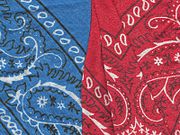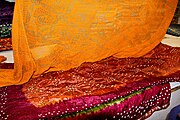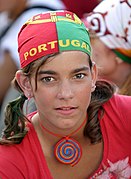Kerchief

A kerchief (from the
The neckerchief and handkerchief are related items.
Types
Bandana

A bandana or bandanna (from Hindi and Urdu, ultimately from Sanskrit बन्धन or bandhana, "a bond")[2] is a type of large, usually colourful kerchief, originating from the Indian subcontinent, often worn on the head or around the neck of a person. Bandanas are frequently printed in a paisley pattern and are most often used to hold hair back, either as a fashionable head accessory or for practical purposes. It is also used to tie around the neck to prevent sunburn, and around the mouth and nose to protect from dust inhalation or to hide the identity of its wearer.
The word bandana stems from the Hindi words 'bāndhnū,' or "tie-dyeing," and 'bāndhnā,' "to tie." These stem from Sanskrit roots 'badhnāti,' "he ties," and Sanskrit 'bandhana' (बन्धन), "a bond."[3] In the 18th and 19th centuries bandanas were frequently known as bandannoes.[4]
Bandanas originated in India as bright-coloured handkerchiefs of silk and cotton with spots in white on coloured grounds, chiefly red and blue Bandhani. The silk styles were made of the finest-quality yarns and were popular. Bandana prints for clothing were first produced in Glasgow from cotton yarns, and are now made in many qualities. The term, at present, generally means a fabric in printed styles, whether silk, silk and cotton, or all cotton.[5]
The bandana found popularity in the US during the late 1700s because
Around the same time, bandanas also became popular with motorcyclists, particularly with Harley-Davidson riders and bikers.[citation needed] In the 1970s paisley bandanas also became popular amongst gangs in California, most notably with two well-known rival gangs, the Bloods, who wore red bandanas, and the Crips, who wore blue ones.[8]
Green bandanas have become a symbol of the abortion-rights movement.[9]
Oramal

The Oramal is a traditional kerchief used in Central Asia and the Caucasus (note how it is tied, the neck is usually not covered by it). In some countries like Uzbekistan, it was traditionally used only at home, while in public the paranja was more popular. In other countries, like Kazakhstan, it was commonly used in public. In Kyrgyzstan, the white color is an indication that the woman is married.
As well it was widely used by men at horse riding in summertime instead of wearing a cap.
Austronesian headscarves
Kerchiefs are also worn as
See also
|
Other neckwear: |
Other headwear
|
References
- ISBN 978-0-85785-363-9.
Following the general Anabaptist worldview, Hutterite dress not only emphasizes modesty but also separation from the world. ... The women wear ankle-length skirts or dresses with a blouse, a kerchief-style head covering with polka dots (tiechle), usually black and white, and solid comfortable shoes.
- ^ "Definition of bandanna". Merriam-webster.com. 2012-08-31. Retrieved 2013-03-15.
- ^ "Bandanna from Dictionary.com". Dictionary.reference.com. Retrieved 2017-06-10.
- ^ Yule and Burnell (2013), "Bandanna", p.78.
- ^ Curtis, H. P. (1921). Glossary of Textile Terms. Marsden & Co. Ltd.
- ^ Hilgers, Laura (November 2020). "The Global History of the Bandana". Smithsonian Magazine. Retrieved 14 March 2024.
- ^ "Nine-Things-You-Didnt-Know-About-Willie-Nelson". 6 June 2012. Retrieved 2021-01-19.
- ISSN 0950-4125.
- ^ "How the green bandanna became a symbol of the abortion rights movement". The Seattle Times. 2022-07-07. Retrieved 2023-06-19.
- Additional sources
- Hilger, Laura (November 2020). "The Global History of the Bandana". Smithsonian Magazine.
- Yule, Henry, & A.C. Burnell (2013). Hobson-Jobson: The Definitive Glossary of British India. (Oxford, England: OUP). ISBN 9780191645839.





